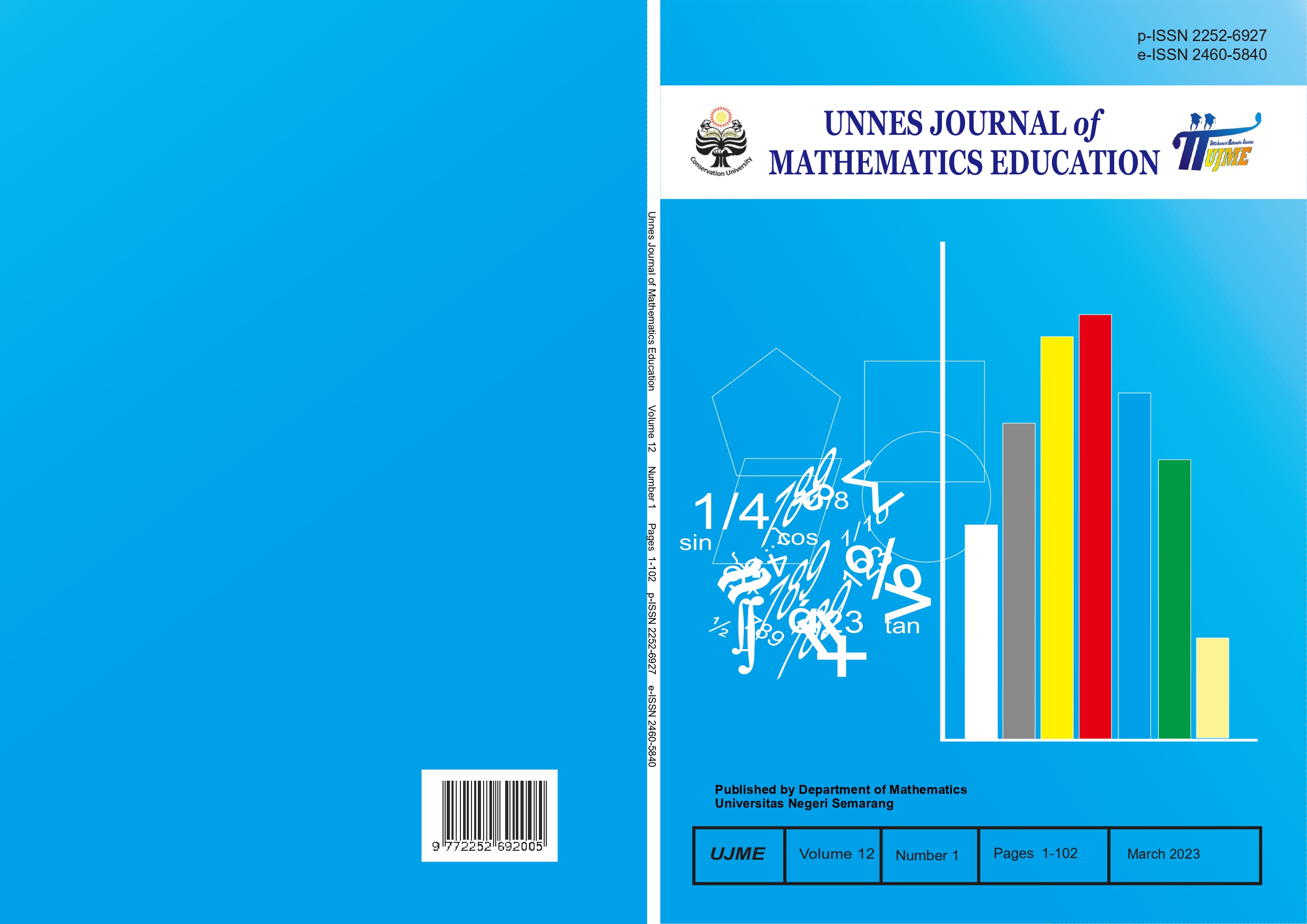Students’ Mathematical Literacy Ability in Terms of Self Efficacy Through Problem Based Learning with PMRI Approach
##plugins.themes.academic_pro.article.main##
Abstract
This research aims to (1) find out whether mathematical literacy through Problem-Based Learning with PMRI Approach (PBL-PMRI) achieves Actual Completion Limit (ACL); (2) find out whether mathematical literacy through PBL-PMRI is classically complete; (3) to find out whether the average and proportion of mathematical literacy through PBL-PMRI is more than the average and proportion of mathematical literacy through PBL; (4) knowing whether students' self-efficacy influences mathematical literacy through PBL-PMRI; (5) describe mathematical literacy through PBL-PMRI based on students' self-efficacy. The research method used is a mixed method with a sequential explanatory design. Sampling in this research with cluster random sampling. While taking the subject with purposive sampling. The results of this research are: (1) mathematical literacy through PBL learning with the PMRI approach achieves Actual Completion Limit (ACL); (2) mathematical literacy through PBL-PMRI learning achieves classical mastery; (3) the average and proportion of students' mathematical literacy through PBL-PMRI are more than the average and proportion of mathematical literacy through PBL; (4) self-efficacy affects mathematical literacy through PBL-PMRI; (5) description of students' mathematical literacy with categories: (a) self-efficacy on fulfilling the four indicators; (b) self-efficacy is in the moderate of fulfilling 3 indicators and tends not to fulfill 1 indicator; (c) lower self-efficacy tends to fulfill 2 indicators, tends not to fulfill 1 indicator, and does not fulfill 1 indicator.
##plugins.themes.academic_pro.article.details##
References
Fajri, H. N., Johar, R., & Ikhsan, M. (2016). Peningkatan Kemampuan Spasial dan Self-Efficacy Siswa Melalui Model Discovery Learning Berbasis Multimedia. Beta Jurnal Tadris Matematika, 9(2), 180. https://doi.org/10.20414/betajtm.v9i2.14
Hidayat, R. A., & Noer, S. H. (2021). Analisis kemampuan berpikir kritis matematis ditinjau dari self efficacy siswa dalam pembelajaran daring. Media Pendidikan Matematika, 9(2), 1. https://doi.org/10.33394/mpm.v9i2.4224
Isnaeni, S., Fajriyah, L., Risky, E. S., Purwasih, R., & Hidayat, W. (2018). Analisis Kemampuan Penalaran Matematis dan Kemandirian Belajar Siswa SMP pada Materi Persamaan Garis Lurus. Journal of Medives : Journal of Mathematics Education IKIP Veteran Semarang, 2(1), 107. https://doi.org/10.31331/medives.v2i1.528
Kemendikbud. (2013). Materi Pelatihan Guru Matematika SMP/MTs tentang Implementasi Kurikulum 2013. Kemendikbud.
Leonardo, & Amanah, N. (2014). Pengaruh Advertisy Quotient dan Kemampuan Berpikir Kritis Terhadap Prestasi Belajar Matematika. Jurnal Perspektif Ilmu Pendidikan, 28(1), 55–64.
Najiha Nadia, L., & Budi Waluyo, S. (2017). Unnes Journal of Mathematics Education Research Analisis Kemampuan Representasi Matematis Ditinjau dari Self Efficacy Peserta Didik melalui Inductive Discovery Learning. Ujmer, 6(2), 242–250. http://journal.unnes.ac.id/sju/index.php/ujmer
NCTM. (2000). Principles And Standards For School Mathematics. The National Council of Teaching of Mathematics.
Nolaputra, A. P., Wardono, & Supriyono. (2018). Analisis Kemampuan Literasi Matematika pada Pembelajaran PBL Pendekatan RME Berbantuan Schoology Siswa SMP. Prosiding Seminar Nasional Matematika, 1, 18–32. https://journal.unnes.ac.id/sju/index.php/prisma/article/view/19672
OECD. (2016). PISA 2015 Results (Volume I): Excellence and Equity in Education: Vol. I. OECD Publishing. https://doi.org/10.1787/9789264266490-5-en
Oktiningrum, W., Zulkardi., & Hartono, Y. (2016). Developing PISA-Like Mathematics Task with Indonesia Natural and Cultural Heritage As Context To Assess Students Mathematical Literacy. Journal on Mathematic Education, 7(1), 1–8. https://ejournal.unsri.ac.id/index.php/jme/article/view/2812/0
Putrisari, F., Hambali, I. M., & Handarini, D. M. (2017). siswa madrasah aliyah negeri di Malang Raya. 1(1), 60–68.
Rajagukguk, W., & Hazrati, K. (2021). Analisis Self-Efficacy Siswa dalam Penelitian Pembelajaran Matematika dengan Pendekatan Matematika Realistik dan Inkuiri. Jurnal Cendekia : Jurnal Pendidikan Matematika, 5(2), 2077–2089. https://doi.org/10.31004/cendekia.v5i2.761
Subaidi, A. (2016). Self-efficacy Siswa dalam Pemecahan Masalah Matematika. Sigma, 1(2), 64–68.
Utami, N., Sukestiyarno, Y. L., & Hidayah, I. (2020). Kemampuan Literasi dalam Menyelesaikan Soal Cerita Siswa Kelas IX A. Prisma, Prosiding Seminar Nasional Matematika, 3, 626–633.
Wardono, & Mariani, S. (2014). The Realistic Learning Model With Character Education and PISA Assesment to Improve Mathematics Literacy. International Journal of Education and Research, 2(7), 361–372.
